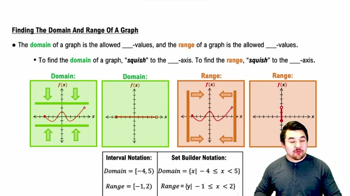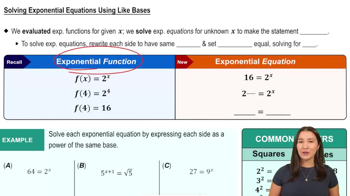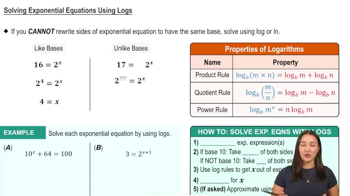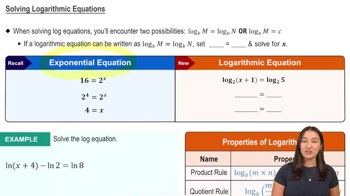Table of contents
- 0. Functions7h 52m
- Introduction to Functions16m
- Piecewise Functions10m
- Properties of Functions9m
- Common Functions1h 8m
- Transformations5m
- Combining Functions27m
- Exponent rules32m
- Exponential Functions28m
- Logarithmic Functions24m
- Properties of Logarithms34m
- Exponential & Logarithmic Equations35m
- Introduction to Trigonometric Functions38m
- Graphs of Trigonometric Functions44m
- Trigonometric Identities47m
- Inverse Trigonometric Functions48m
- 1. Limits and Continuity2h 2m
- 2. Intro to Derivatives1h 33m
- 3. Techniques of Differentiation3h 18m
- 4. Applications of Derivatives2h 38m
- 5. Graphical Applications of Derivatives6h 2m
- 6. Derivatives of Inverse, Exponential, & Logarithmic Functions2h 37m
- 7. Antiderivatives & Indefinite Integrals1h 26m
- 8. Definite Integrals4h 44m
- 9. Graphical Applications of Integrals2h 27m
- 10. Physics Applications of Integrals 2h 22m
0. Functions
Exponential & Logarithmic Equations
Problem 1.87
Textbook Question
Finding all inverses Find all the inverses associated with the following functions, and state their domains.
ƒ(x) = (x + 1)³
 Verified step by step guidance
Verified step by step guidance1
Step 1: To find the inverse of the function \( f(x) = (x + 1)^3 \), start by replacing \( f(x) \) with \( y \). This gives us the equation \( y = (x + 1)^3 \).
Step 2: Swap the variables \( x \) and \( y \) to begin solving for the inverse. This results in the equation \( x = (y + 1)^3 \).
Step 3: Solve for \( y \) by taking the cube root of both sides to isolate \( y + 1 \). This gives \( \sqrt[3]{x} = y + 1 \).
Step 4: Isolate \( y \) by subtracting 1 from both sides of the equation. This results in \( y = \sqrt[3]{x} - 1 \).
Step 5: The inverse function is \( f^{-1}(x) = \sqrt[3]{x} - 1 \). The domain of the inverse function is all real numbers, \( \mathbb{R} \), since the cube root function is defined for all real numbers.
 Verified video answer for a similar problem:
Verified video answer for a similar problem:This video solution was recommended by our tutors as helpful for the problem above
Video duration:
3mPlay a video:
Was this helpful?
Key Concepts
Here are the essential concepts you must grasp in order to answer the question correctly.
Inverse Functions
An inverse function essentially reverses the effect of the original function. If a function f takes an input x and produces an output y, the inverse function f⁻¹ takes y back to x. For a function to have an inverse, it must be one-to-one, meaning each output is produced by exactly one input.
Recommended video:

Inverse Cosine
Finding Inverses Algebraically
To find the inverse of a function algebraically, you typically replace f(x) with y, then solve for x in terms of y. After isolating x, you swap x and y to express the inverse function. This process often involves algebraic manipulation and may require checking for restrictions on the domain.
Recommended video:

Inverse Cosine
Domain and Range
The domain of a function is the set of all possible input values (x-values), while the range is the set of all possible output values (y-values). When finding the inverse of a function, the domain of the original function becomes the range of the inverse, and vice versa. Understanding these concepts is crucial for accurately determining the domains of both the original and inverse functions.
Recommended video:

Finding the Domain and Range of a Graph

 4:46m
4:46mWatch next
Master Solving Exponential Equations Using Like Bases with a bite sized video explanation from Callie
Start learningRelated Videos
Related Practice




